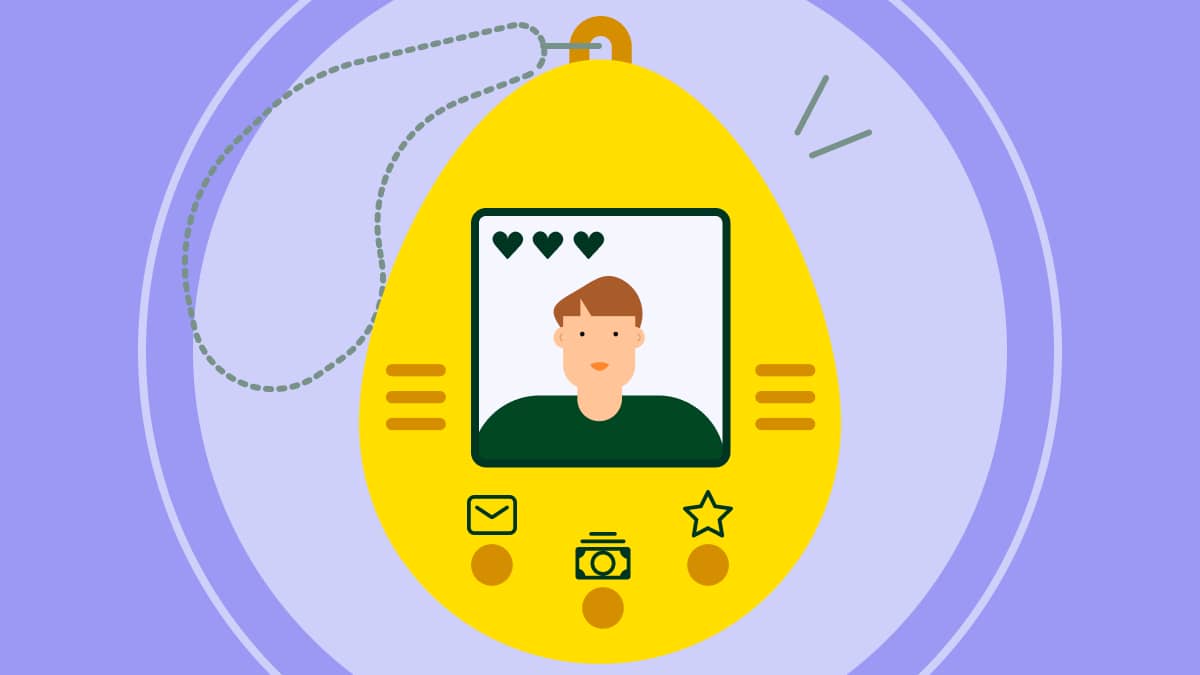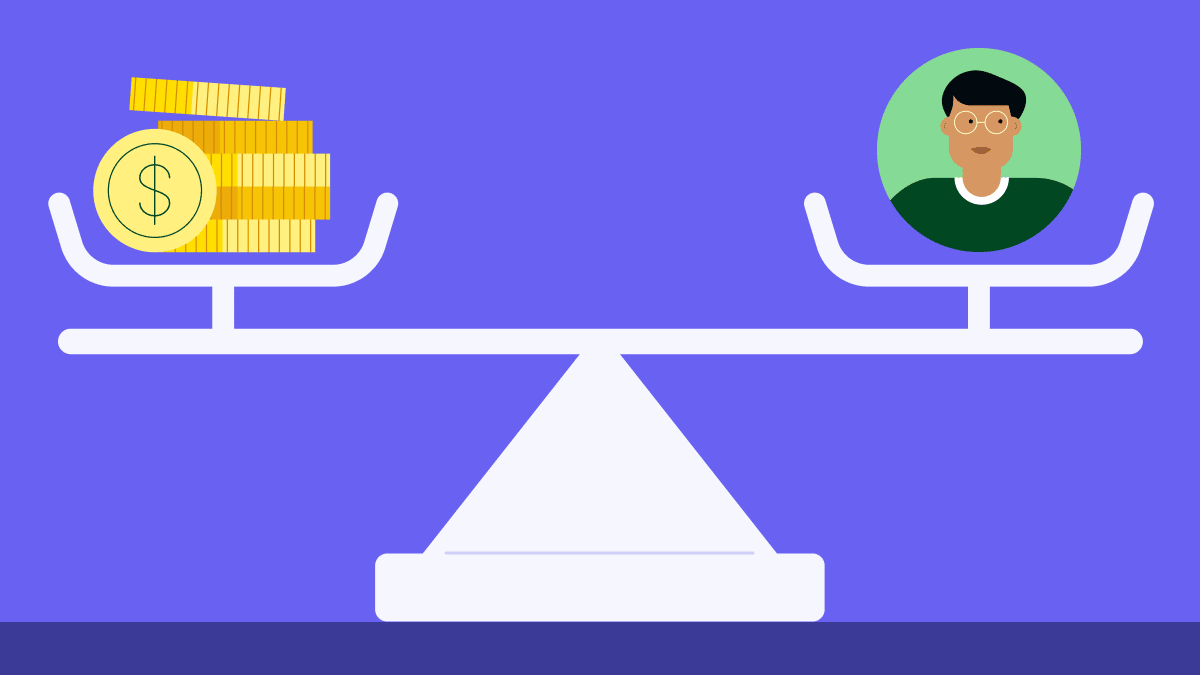Even with the best acquisition strategy, high churn will eat away at your revenue. Retention marketing helps keep the buyers you’ve worked hard to win so that your growth stays on track.
In this article, you’ll learn practical retention marketing strategies that make your customers feel valued and encourage repeat business. You’ll get seven tactics you can use in any SMB scenario, with examples, tools and tips for monitoring your results.
Key takeaways from retention marketing
Retention marketing focuses on turning first-time buyers into long-term customers and increasing their value to your business.
Personalized experiences and data-driven follow-ups strengthen relationships and improve repeat purchase behavior.
Tracking engagement and renewal pipelines helps identify at-risk customers and reveals which campaigns drive results.
Pipedrive makes it easy to manage retention marketing campaigns and monitor performance in one place – try it free for 14 days.
What is retention marketing?
Retention marketing is an umbrella term for strategies that keep customers engaged and prevent churn. The end goal is that buyers stick around longer and customer lifetime value (CLV) increases.
Traditionally, the customer success team owns buyer retention – the business goal of successfully keeping existing customers. Marketing supports this goal through campaigns that build loyalty and encourage repeat use, such as:
Email campaigns to re-engage inactive customers. A B2B agency might email past clients who haven’t booked a project in the last year and share recent successful case studies to boost customer engagement.
Loyalty or referral programs. A software reseller could offer discounted rates or early access to new tools for clients who renew their contracts.
Educational content that helps customers get more value. A consulting firm might run webinars showing clients how to measure return on investment (ROI) from the services they’ve already bought.
Exclusive offers based on past customer behavior. A marketing agency could send tailored upsell offers, such as social media management services for clients who purchased LinkedIn design packages.
Today, more companies recognize that retention depends on the entire customer journey, not just the touchpoints that happen after purchase. That’s why sales teams now play a bigger role alongside marketing and customer success.
Customer retention marketing is a shared responsibility, and the best results come when these teams work together instead of in silos.
Note: A customer relationship management (CRM) tool like Pipedrive helps teams coordinate retention efforts. With one shared system, all teams can see the same data on customer health and deal history. This visibility makes it easier to spot risks and step in at the right moment.
Why SMBS should prioritize retention marketing
For small and medium-sized businesses (SMBs) with fewer resources than enterprise firms, getting more value from existing customers goes beyond cost savings.
Here are the key benefits showing why retention marketing is essential for SMBs:
Benefit | Why it matters |
Lower cost than acquiring new customers |
|
Compounding CLV |
|
Stronger brand advocacy |
|
To get these benefits without adding too much complexity, SMBs should choose retention marketing tactics that are easy to implement and measure.
7 customer retention marketing strategies (and how to track them)
These tactics help you increase customer retention by building on each other to create a complete, connected customer experience.
1. Onboarding campaigns that stick
A clear onboarding campaign using emails and in-product SaaS tutorials guides new users through the steps that matter most. The first days after a purchase are critical, as this is when customers are most motivated and excited to use your product.
Leading customers to an early win reduces frustration and creates a better user experience.
Here’s an example from novel writing software Novelpad, showing new users how to add their first scene step-by-step:
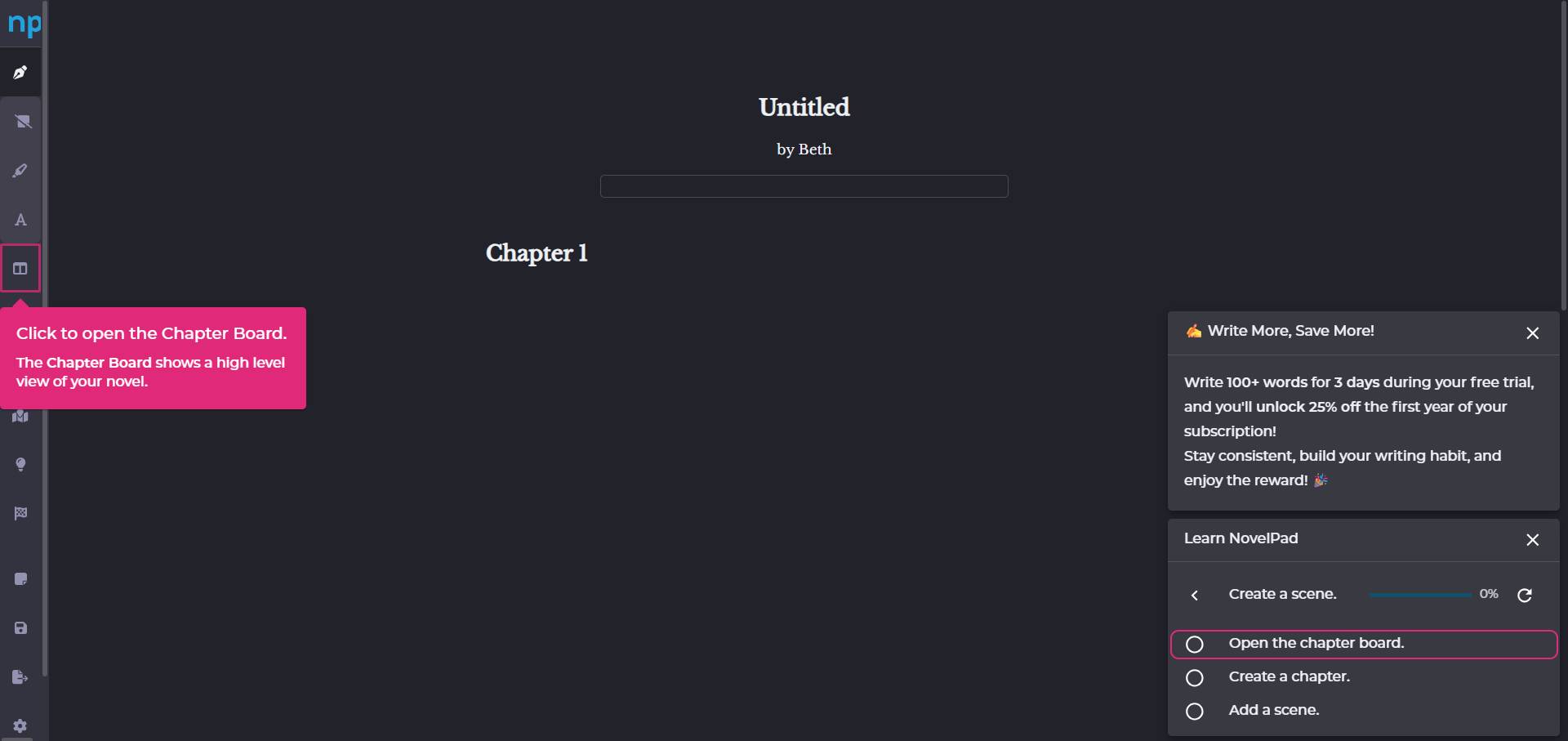
Along with tool tips and a checklist, an introductory offer encourages new users to work through the steps.
When customers feel progress right away, they’re more likely to build habits and keep coming back.
Track onboarding in Pipedrive with Salespanel
Custify is a tool that tracks customer behavior inside your product, including the steps and actions they’ve taken. By connecting it to Pipedrive, you can see this activity directly in your CRM.
In Pipedrive, create a pipeline stage called “Onboarding” to keep track of new customers who are still getting started.

For each contact in the onboarding stage, create an activity for a customer success manager to check in on their progress.
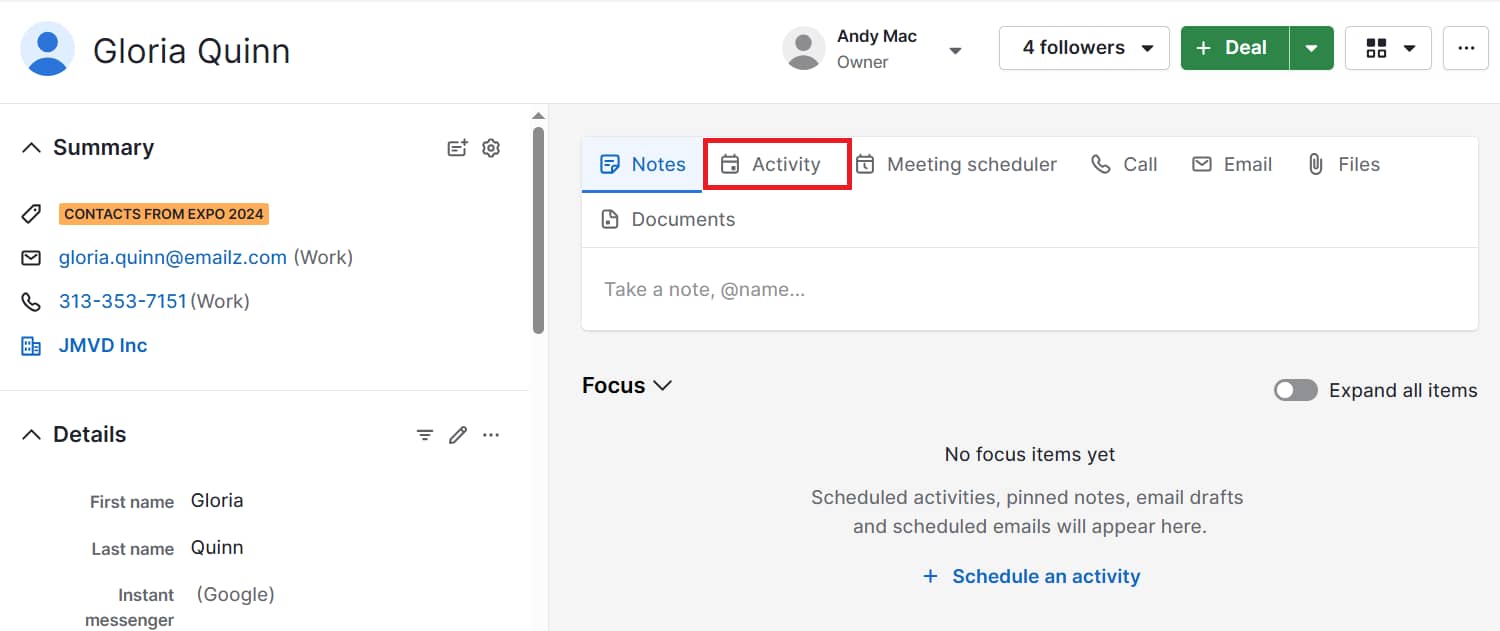
From the Custify data, customer success teams can see if a contact is stuck in the onboarding process. They can reach out with a personalized email or a call to offer their help.
Pipedrive in action: Lowlander Beer used Pipedrive to streamline new account onboarding, reducing onboarding time by 45%. It also built structured post-sale steps, including account checks and training, so customers receive consistent guidance after purchase.
2. Automated renewal and upsell reminders
Contacting customers before their contracts end helps prevent accounts from lapsing. It reminds customers of the value they get and gives them a chance to renew or upgrade.
Here’s an email Vimeo sends customers with gift subscriptions that are about to expire:

The email prompts recipients to continue their subscription by mentioning:
Something they’ll miss out on (new episodes).
A benefit (watch anytime, anywhere.
How to track renewals in Pipedrive
Create a separate pipeline for subscription or service renewals in the CRM’s pipeline view.
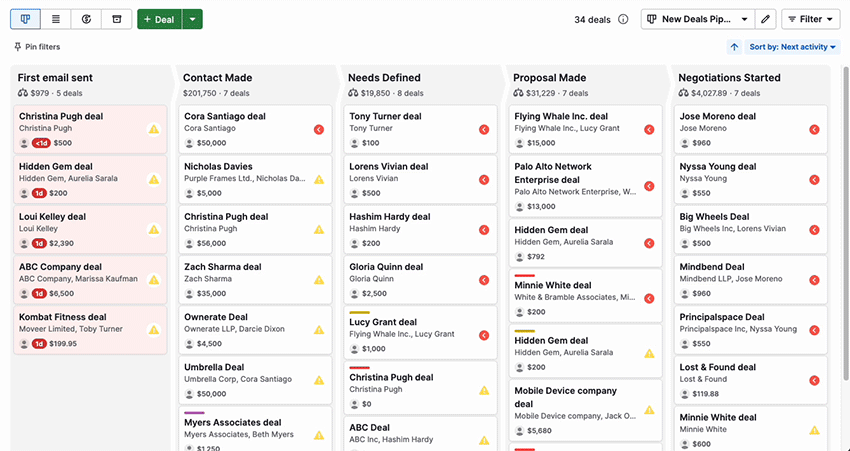
Using the workflow automation feature, create an automatic trigger to move the deal to the renewal pipeline when the status changes to “won”.
Create an activity for a sales rep to contact the customer about their renewal and close the deal. For example, if they have a yearly subscription, set the due date for 11 months’ time.
Pipedrive in action: Marmelada Market struggled to manage renewals despite being fast with new leads. Using Pipedrive, it automated deals to renew a month before expiration, which contributed to cutting time spent on sales and admin tasks by over 50%.
3. Personalized check-ins for at-risk customers
If a user stops logging into your product as often or their purchase frequency drops, they might be at risk of leaving. Noticing these signals early lets your team intervene before the customer churns.
Reach out with tips, support or a promotion to encourage the customer to keep using your product. Here’s how Typeform does it:
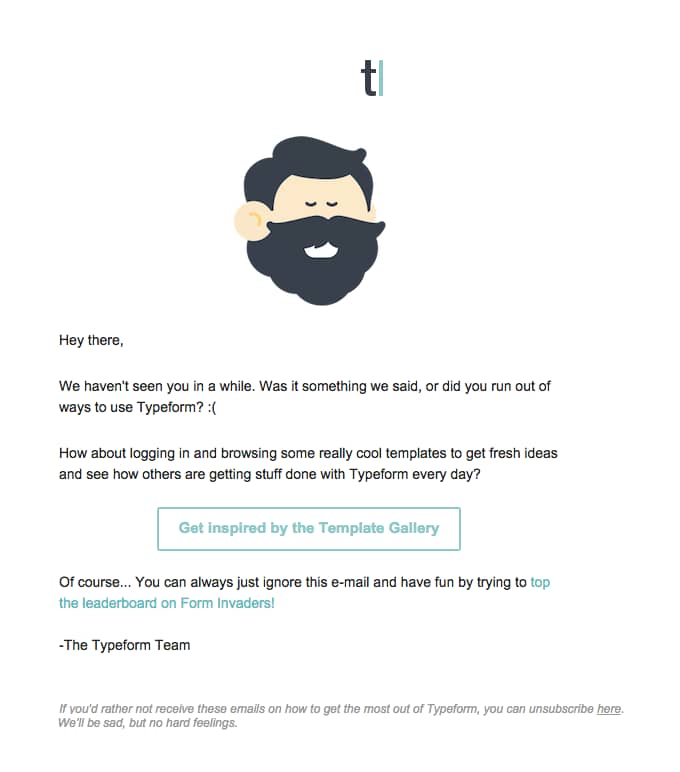
The email encourages users to do something simple: check out the template gallery. The templates inspire users to create their own forms and surveys, bringing them back to the platform.
Identify at-risk customers in Pipedrive
In addition to providing product usage data, the Pipedrive-Custify integration assigns health scores using signals like the last login or the number of support tickets.
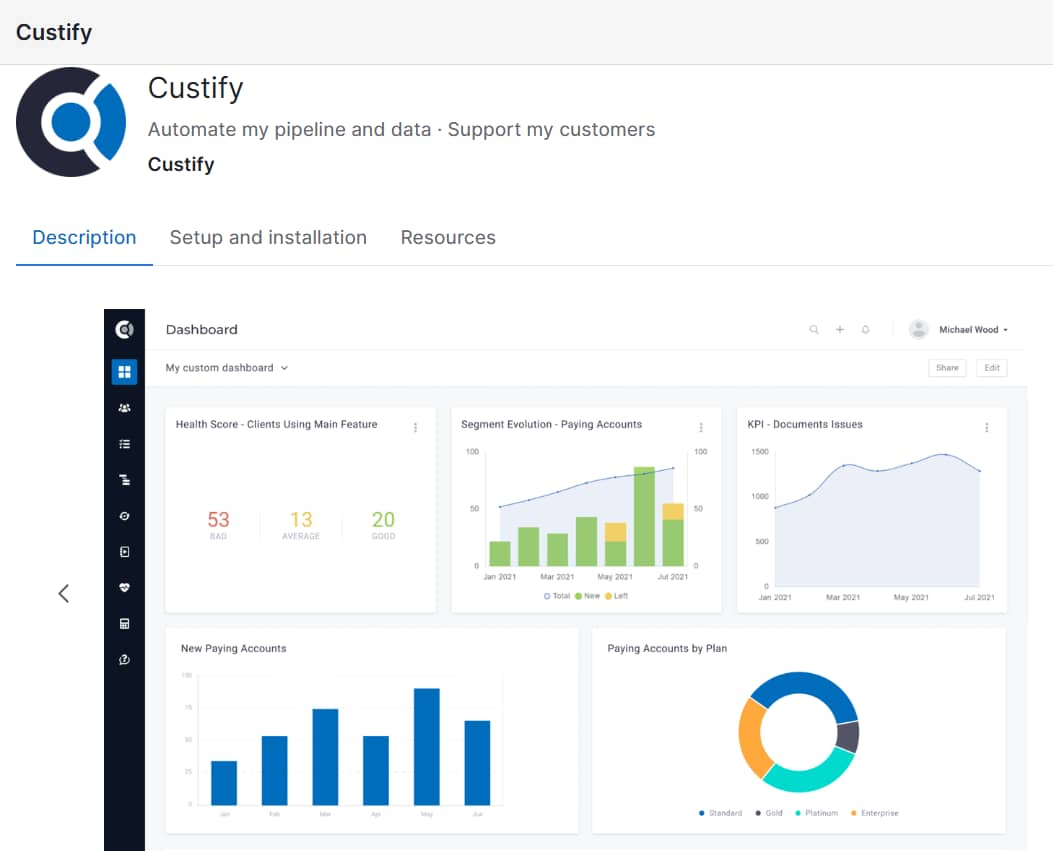
You receive alerts directly in Pipedrive when a health score drops, identifying at-risk customers so you can take action in real time.
4. Milestone and loyalty campaigns
Celebrating customer milestones, like anniversaries or usage achievements, helps strengthen the emotional connection with your brand as part of an emotional selling strategy. Sending a timely message or offer delights the customer, encouraging long-term loyalty.
Here’s an anniversary email from Semrush:
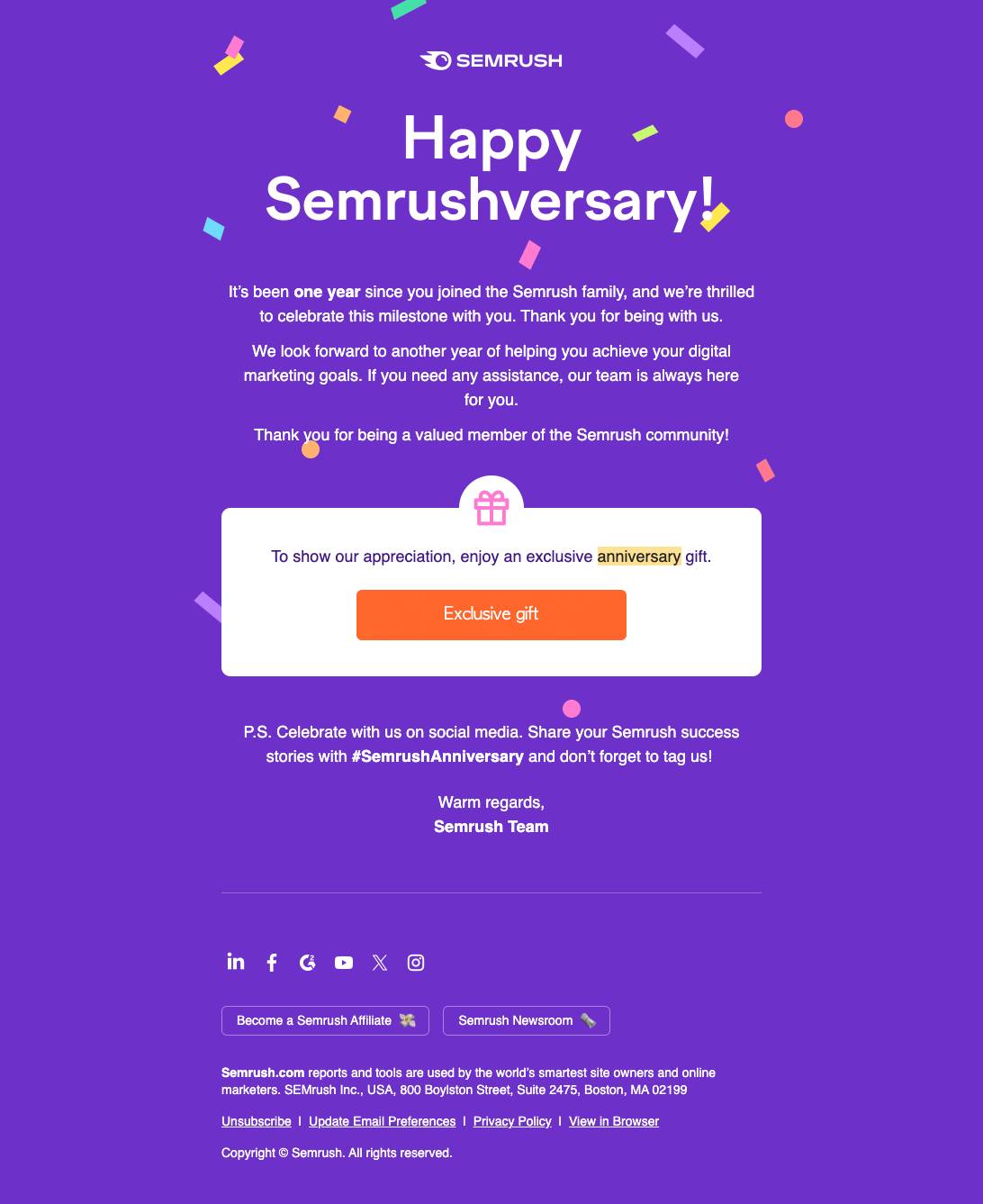
The email shows genuine customer appreciation and includes a gift to keep the recipient using the platform.
Track milestone and loyalty campaigns in Pipedrive
Use Pipedrive’s workflow automation to trigger tasks or emails when a milestone approaches. Create an activity with a subject like “Send anniversary message” and set the date to a week before their anniversary (to give the customer success manager or sales rep enough notice).
Note: While full-scale loyalty programs are high-value, they can be difficult and expensive for SMBs to manage. Personalized milestone emails are a lightweight alternative for offering many of the same benefits, minus the complexity of a structured program.
5. Segmented email marketing campaigns for repeat purchases
Sending follow-up emails based on purchase history makes your outreach feel more relevant and timely. Instead of an email shot with a generic promotion, you guide each customer base to their next step or give tailored product recommendations.
For example, you could:
Offer advanced training after they buy a starter course
Recommend accessories after a hardware purchase
This approach increases the chance of repeat sales and strengthens the customer relationship.
Netflix often uses this strategy.

It sends customer-centric emails with personalized subject lines when it adds a TV series or movie it thinks you’ll like based on your watch history.
Send segmented emails in Pipedrive
With Campaigns by Pipedrive, you can easily segment your email lists based on activities and products. For each segment, create drip sequences related to the product they bought.
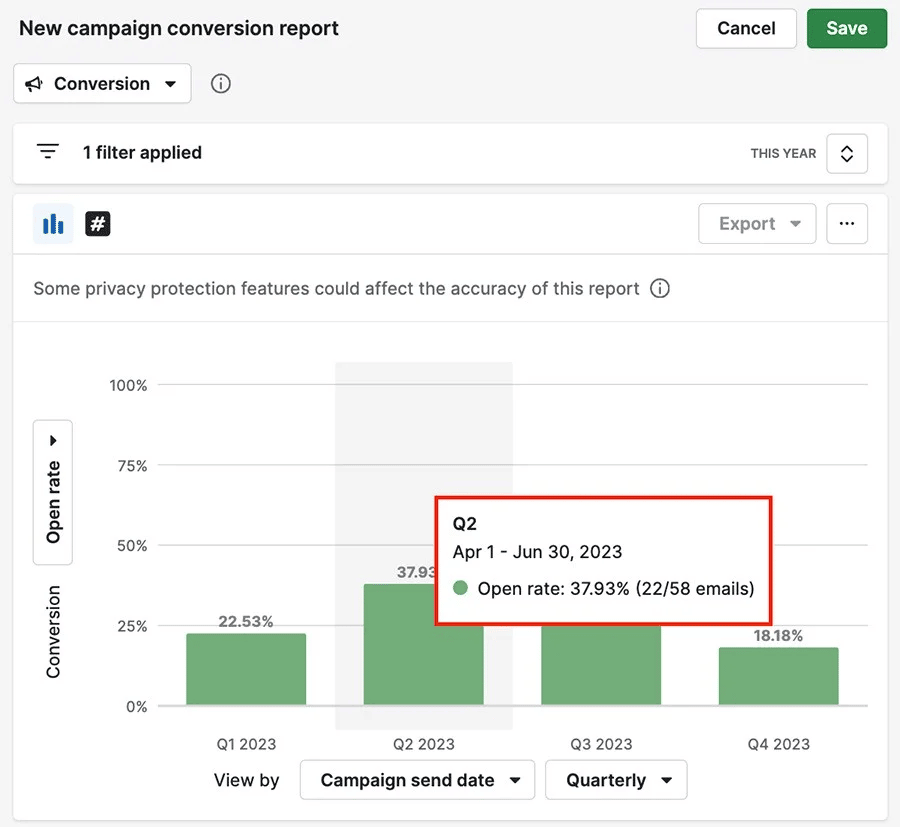
You can track your sequences with Campaigns’ built-in analytics. The campaign conversions report shows the percentage of recipients who opened your emails and clicked through.
6. Feedback loops and Net Promoter Score (NPS) follow-ups
A structured approach to collecting customer feedback, also known as voice of the customer (VoC), helps you spot dissatisfied customers so you can take action before they churn.
NPS is a common VoC metric for determining customer loyalty. The score asks buyers how likely they are to recommend your product or service on a scale from zero to 10.
Low scores indicate people who may be at risk of churning. High scores show brand advocates who can help spread positive word-of-mouth about their customer experience.
You can collect NPS with a simple SMS, push notifications or email like this one from Squarespace:
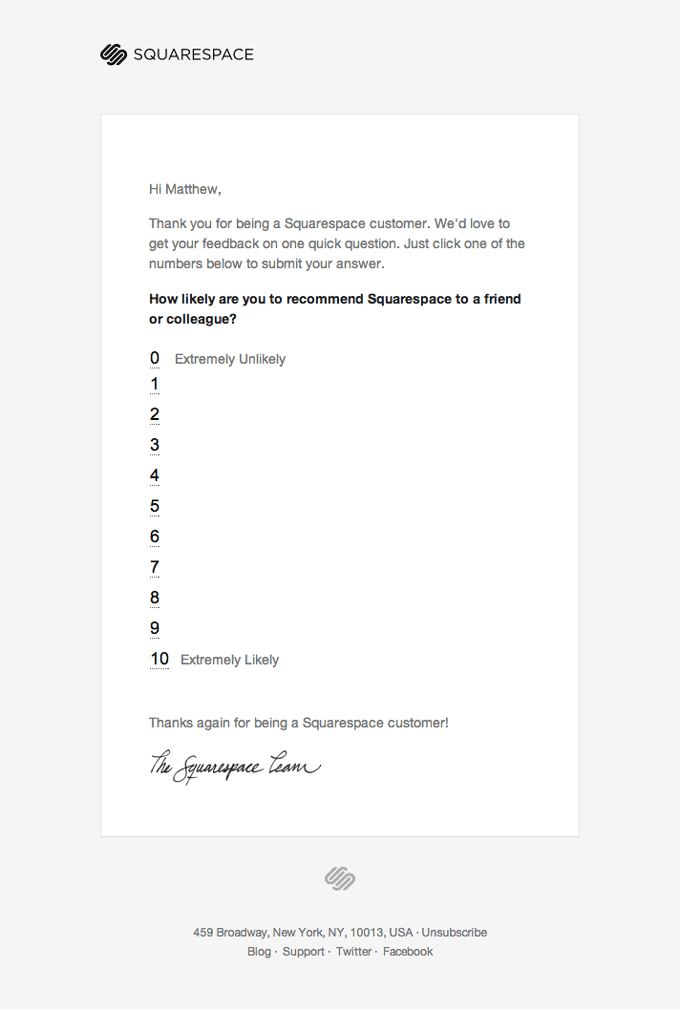
Some email platforms include NPS templates, or you can set yours up using a platform like SurveyMonkey.
Following up on NPS feedback shows customers that you care about customer satisfaction and can help address issues that could lead to churn.
Keep track of NPS in Pipedrive
Add a custom NPS field for your contacts in Pipedrive by going to “Personal preferences > Data fields > + Custom field”.

When you receive NPS responses from a customer, add the score to the field. Sort contacts according to their score so you can easily see which customers gave a low rating.
Set up an activity for a customer success manager or customer support to reach out. They can learn the reason for the customer’s score and what they can do to resolve it.
7. Win-back campaigns for lapsed customers
Re-engaging past customers who have gone quiet is often more cost-effective than acquiring new ones. These customers already know you, so an update about new products or an offer can spark their interest again.
Audible uses this customer retention strategy with regular sales promotions.

If a customer enjoyed the service but not enough to pay full price, the right offer could be enough to bring them back.
Run win-back campaigns in Pipedrive
If you set up a renewal pipeline as described in step two, you can create an activity to periodically check which renewal deals didn’t move forward.
Add these to a dedicated win-back segment in Campaigns and send re-engagement emails or assign follow-up tasks to a sales rep.
Track performance by monitoring how many inactive customers return after receiving your win-back sequence.
Download Your Guide to Sales Performance Measurement
How to measure your retention marketing success
For SMBs, the key to measuring customer retention is to focus on just one or two metrics. Here are some options and scenarios that they suit best.
Metric | When to use it |
Churn rate (% of lost customers over a period) | If you run subscriptions or recurring services and want to know how fast customers are leaving. |
Customer retention rate (% retained over a period) | If you want a positive measure of customer loyalty to balance churn data. |
CLV | If you need to decide how much you can spend on acquisition or retention campaigns. |
Revenue from existing customers (%) | If upsells, renewals or repeat purchases are a major part of your growth strategy. |
Pipeline health (number/value of renewal and upsell deals) | If you manage renewals and expansions through a CRM pipeline. |
Engagement trends (activities per customer, email opens, logins, etc.) | If you want early signals from at-risk customers before they churn. |
Start with churn and retention rate for a big-picture view. Add CLV when you’re budgeting, or engagement metrics if you need leading risk indicators. The goal is to pick only the ones that help you make decisions, not overwhelm yourself with data.
Example: Say a subscription-based marketing agency sees churn spike by 10% after introducing a new pricing tier. After sending surveys to the customers who left, the agency learns that many were confused by the changes and felt they weren’t getting enough value.
In response, the agency adds an onboarding email series explaining the tier benefits and offers a consultation for new subscribers, helping to bring churn back down.
In Pipedrive, you can create an Insights Revenue Forecast report and filter it to show only renewal deals (if you’ve tagged them or moved them to a renewal pipeline).
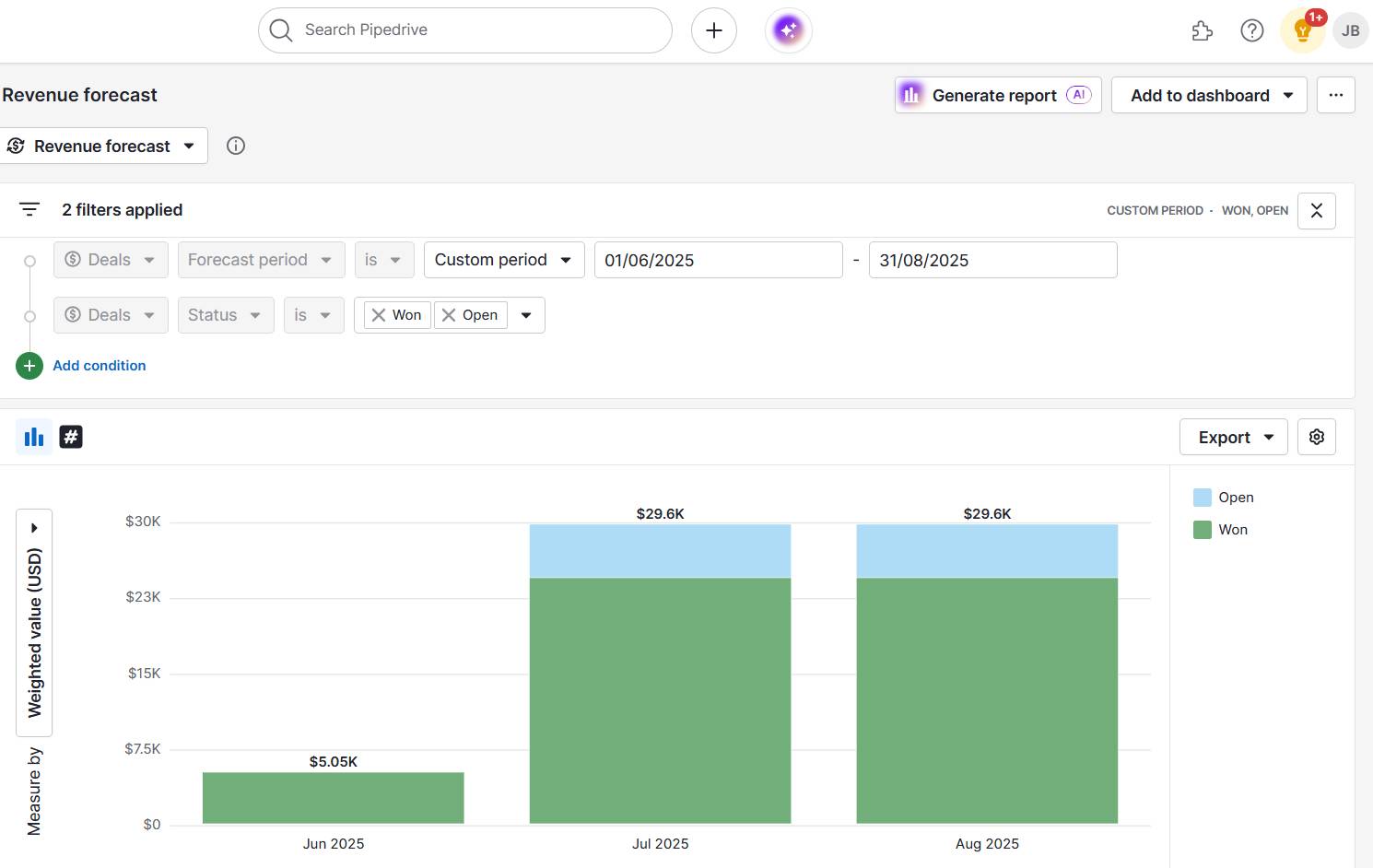
The report makes it easier to spot whether your retention strategies are paying off in real time.
Final thoughts
Retention marketing works when you act on real-time customer data to guide interactions and build long-term relationships. Start with simple campaigns for your current customers, track how they respond and use that insight to optimize your client retention marketing strategies.
Pipedrive helps you measure your retention marketing efforts and manage customer relationships in one place. Try it free for 14 days to start attracting repeat customers for your business.
